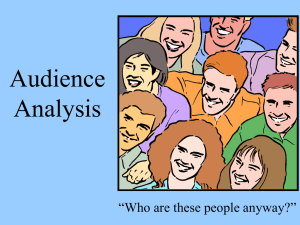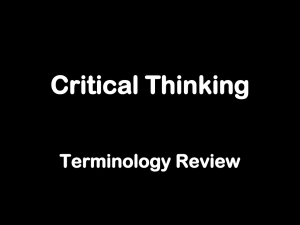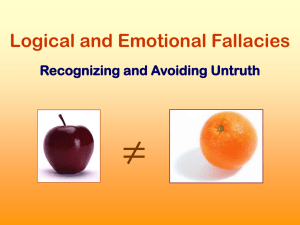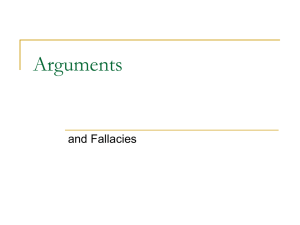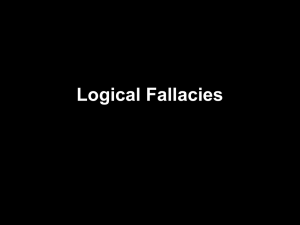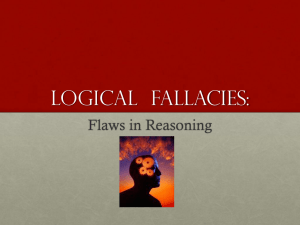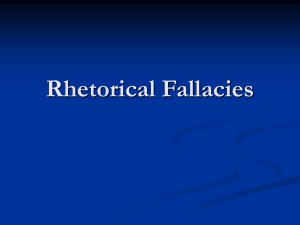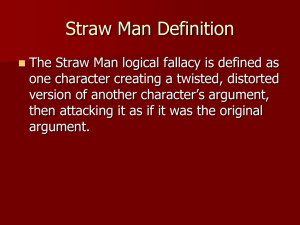41.1k - David W. Agler
advertisement
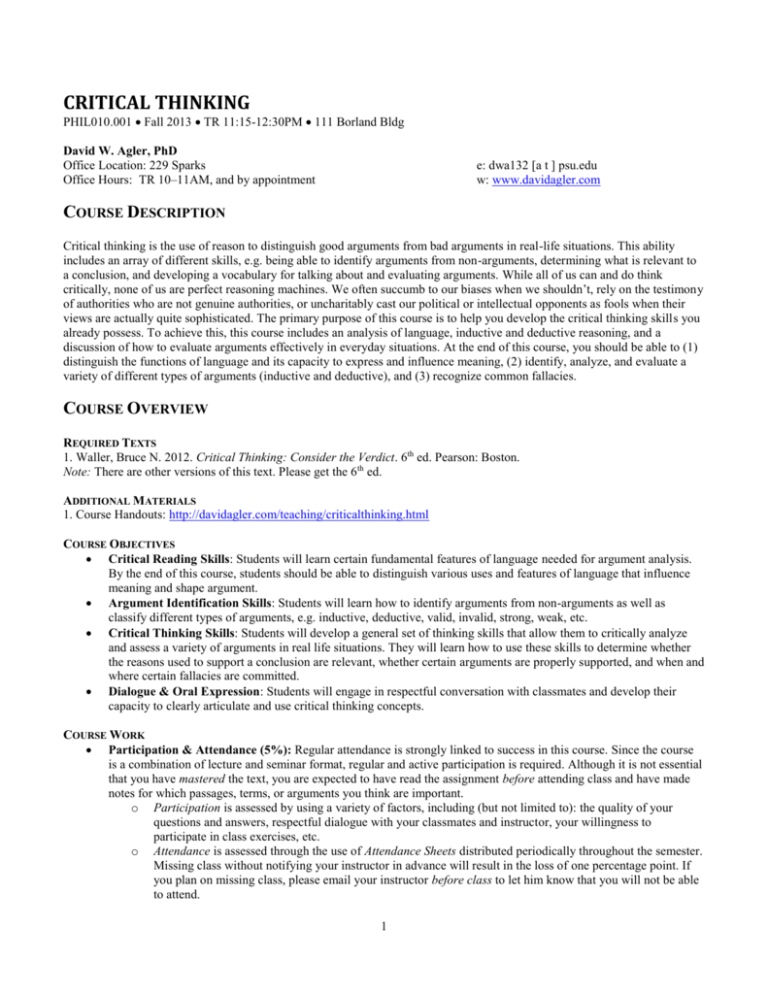
CRITICAL THINKING PHIL010.001 Fall 2013 TR 11:15-12:30PM 111 Borland Bldg David W. Agler, PhD Office Location: 229 Sparks Office Hours: TR 10–11AM, and by appointment e: dwa132 [a t ] psu.edu w: www.davidagler.com COURSE DESCRIPTION Critical thinking is the use of reason to distinguish good arguments from bad arguments in real-life situations. This ability includes an array of different skills, e.g. being able to identify arguments from non-arguments, determining what is relevant to a conclusion, and developing a vocabulary for talking about and evaluating arguments. While all of us can and do think critically, none of us are perfect reasoning machines. We often succumb to our biases when we shouldn’t, rely on the testimony of authorities who are not genuine authorities, or uncharitably cast our political or intellectual opponents as fools when their views are actually quite sophisticated. The primary purpose of this course is to help you develop the critical thinking skills you already possess. To achieve this, this course includes an analysis of language, inductive and deductive reasoning, and a discussion of how to evaluate arguments effectively in everyday situations. At the end of this course, you should be able to (1) distinguish the functions of language and its capacity to express and influence meaning, (2) identify, analyze, and evaluate a variety of different types of arguments (inductive and deductive), and (3) recognize common fallacies. COURSE OVERVIEW REQUIRED TEXTS 1. Waller, Bruce N. 2012. Critical Thinking: Consider the Verdict. 6th ed. Pearson: Boston. Note: There are other versions of this text. Please get the 6th ed. ADDITIONAL MATERIALS 1. Course Handouts: http://davidagler.com/teaching/criticalthinking.html COURSE OBJECTIVES Critical Reading Skills: Students will learn certain fundamental features of language needed for argument analysis. By the end of this course, students should be able to distinguish various uses and features of language that influence meaning and shape argument. Argument Identification Skills: Students will learn how to identify arguments from non-arguments as well as classify different types of arguments, e.g. inductive, deductive, valid, invalid, strong, weak, etc. Critical Thinking Skills: Students will develop a general set of thinking skills that allow them to critically analyze and assess a variety of arguments in real life situations. They will learn how to use these skills to determine whether the reasons used to support a conclusion are relevant, whether certain arguments are properly supported, and when and where certain fallacies are committed. Dialogue & Oral Expression: Students will engage in respectful conversation with classmates and develop their capacity to clearly articulate and use critical thinking concepts. COURSE WORK Participation & Attendance (5%): Regular attendance is strongly linked to success in this course. Since the course is a combination of lecture and seminar format, regular and active participation is required. Although it is not essential that you have mastered the text, you are expected to have read the assignment before attending class and have made notes for which passages, terms, or arguments you think are important. o Participation is assessed by using a variety of factors, including (but not limited to): the quality of your questions and answers, respectful dialogue with your classmates and instructor, your willingness to participate in class exercises, etc. o Attendance is assessed through the use of Attendance Sheets distributed periodically throughout the semester. Missing class without notifying your instructor in advance will result in the loss of one percentage point. If you plan on missing class, please email your instructor before class to let him know that you will not be able to attend. 1 Participation Three Sets of Homework Exercises (15%): 5% Homework exercises are assigned throughout the semester. Each set of homework exercises will be Homework collected when you take the exam that corresponds with 15% that set of homework, e.g. Homework Exercises #1 is due the day you take Exam #1. Homework is reviewed for (i) completeness and (ii) whether it is turned in a professional and organized manner. Completeness is Quizzes defined as putting forward a solid attempt on every exercise assigned. Thus, it is necessary that you answer 24% every homework question but not necessary that you answer every exercise correctly. Failing to complete a problem in an exercise set will not result in a loss of points, but each problem missed thereafter will result in a loss of ten points. The exception is when an exercise set in its entirety is skipped. Turning in professional and organized work is defined as a notebook (or set of stapled papers) with all exercise sets clearly marked and ordered sequentially. Six Pop Quizzes (24%): There will be six pop quizzes this semester with the lowest quiz dropped. In order to do well on pop quizzes, it is sufficient that you have developed a basic familiarity with the assigned reading and the material discussed in class (see “Study Guide for Quiz” at the end of the syllabus). Pop quizzes do not require a mastery of the material. Pop quizzes can be administered at the beginning, middle, or end of the class period. Please note: you cannot make up a pop quiz as the lowest grade is dropped. Three Exams (56%): Three exams are scheduled periodically throughout the semester. In order to do well on the exams, it is necessary that you have developed a basic familiarity with the assigned reading and the material discussed in class. However, exams require a level of understanding of the material that goes above basic familiarity. A review sheet detailing the structure of each exam will be distributed for each exam. You can expect exams to have a structure consisting of questions that (i) require matching key terms to definitions, (ii) multiple-choice questions that test your understanding and ability to apply critical thinking concepts, (iii) short-answer questions that test your ability to define terms and produce examples that illustrate these definitions, and (iv) short-answer questions that ask you to demonstrate your knowledge of critical thinking methods and procedures (some will require you to apply these methods/processes to hypothetical legal cases that we discuss in class). Exams 56% COURSE POLICIES ACADEMIC MISCONDUCT The general principles and policy relating to cheating and plagiarism, which are enforced in this class, can be found in the Penn State policy on academic misconduct. Academic Integrity: Academic dishonesty encompasses a wide range of activities, whether intentional or unintentional, that includes, but is not limited to: all forms of fraud, plagiarism, and any failure to cite explicitly all materials and sources used in one’s work. Sanctions for these activities include, but are not limited to, failure in a course, removal from the degree program, failure in a course with an explanation in the permanent transcript of the cause for failure, suspension, and expulsion. If you are unclear about whether you or someone you know is engaging in academic misconduct, read the following: University Statement on Academic Integrity. For more information, see PSU Academic Integrity, PSU ITS, Plagiarism Tutor, Turnitin, PSU Teaching & Learning with Technology GRADING SCALE & ROUNDING POLICY Grades will be rounded up from the second decimal point, e.g. 90.95 rounds up to 91.0 while 90.94 rounds down to 90.90. In the event that eLION does not allow for a particular grade (e.g. D+), you will simply be given the letter grade (e.g. if you have a D+ then you will receive a D, and if you have a C–, you will receive a C). A: 91–100%; A–: 90.0–90.9 B+: 89.0–89.9 B: 81.0–88.9 B–: 80–80.9 C+: 79.0–79.9 C: 71.0–78.9 C–: 70–70.9 D+: 69.0–69.9 D: 60.0–68.9 F: 0–59.9 INCOMPLETE DROP 2 LATE WORK If you are planning on turning in any of the above assessments late, you will need to clear this with the instructor before the day and time of the assessment. If the instructor is not informed that you will be not able to take an Exam or turn in your homework, a grade reduction of one letter grade is incurred for every day the test/homework is late. So if the due date is Tuesday at 3p.m. and you email me on Tuesday at 3.01p.m., you will lose a letter grade. You will not lose an additional letter grade until 3.01p.m. the next day (i.e. Wednesday). There is no make-up for pop quizzes as one of the quizzes is dropped. STUDENT GUIDANCE AND DISABILITY If you have a documented disability and wish to receive academic accommodations, please contact the campus disability liaison as soon as possible: (name, office, telephone, email). For additional information, check the university web site for Disability Services. If you are in need of psychological counseling, please do not hesitate to contact Penn State’s Counseling & Psychological Services (phone: 814-863-0395). For any problem related to your studies, university policies and procedures, do not hesitate to seek the help of the Student Affairs Services, your Academic Advisor, or arrange a meeting with your instructor who will help you obtain assistance. USE OF ANGEL AND EMAIL COMMUNICATION Please check the webpage on the ANGEL website regularly. Many helpful resources are available there and on my professional website: www.davidagler.com. If you have a question about the course, its content or assignments, I encourage you to go through the following three step process: (1) Check the syllabus (2) Check ANGEL (3) Email me I encourage you to contact me with any concerns you may have about the course. The best way is to get a hold of me is through email at dwa132@psu.edu. If you do email me, I encourage you to use the following practices: Use your Penn State account Include your full name Use a clear subject line, e.g. P120 Question Try to phrase your question as clearly as possible, including any information you think might be helpful. Address your intended recipient, e.g. Dear David Use e-mail for short questions that require short answers. Students are responsible for activity on their computer accounts so only send emails pertinent to the course or to your academic development. TUTORING, DROP PROCEDURES, AND INCOMPLETES Students who simply stop attending class, for whatever reason, without officially withdrawing from the course, will receive the grade of F. If you expect a refund, be aware that the date the withdrawal form is processed by Penn State registrar’s office determines the amount of refund. Consult the Register site for drop procedures. Consult the Handbook for taking an Incomplete (D/F). Before considering dropping the course or taking an incomplete, you might consider getting additional help from your academic advisor or from the following useful links: Information Literacy Tutorial, University Learning Center, Writing Center CLASSROOM ENVIRONMENT A number of factors figure into creating a healthy classroom environment. In order to facilitate such an environment, I ask you to obey the following: (1) the use of cell phones in any capacity is prohibited (please turn ringers/buzzers off, no textmessaging during class), (2) please do not begin to ‘pack up’ your belongings before your instructor has explicitly dismissed you, (3) please come to class rested, sleeping in class is strictly prohibited, (4) please do not do other work in class. If you are incapable of performing (1)–(4) or are disruptive in class, you will kindly be asked to leave the classroom. 3 CHALLENGE EXAMINATION For some courses, students may request a challenge examination as a substitute for completing the usual requirements of a course. If the examination is successfully completed the credits received are described as "credits by examination" (policy 4250). COURSE SCHEDULE Check ANGEL for a detailed schedule that gives the agenda for the course. This includes the agenda in class, homework, and readings. 8/27/13–10/1/13 Part I: Evaluating Arguments Chapter 1: Introduction Chapter 2: A Few Important Terms Chapter 5: What’s the Question? (Identifying the Conclusion) Chapter 6: Relevant and Irrelevant Reasons Chapter 8: The Burden of Proof Exam #1 & Homework Exercises #1 10/1/13 – 11/1/13 Part II: Some Key Fallacies Chapter 3: Ad Hominem Fallacy Chapter 4: Straw man Fallacy Chapter 9: Fallacies of Equivocation Chapter 12: Slippery Slope Fallacy Chapter 12: False Dilemmas Chapter 12: Golden Mean Fallacy Exam #2, Homework Exercises #2 11/1/13–12/18 Part III: Determining the Truth of the Premises Chapter 10: Appeal to Authority Chapter 16: Eye Witness Testimony Chapter X: Chosen by Google Survey Exam 3, Homework Exercises #3 4 HOMEWORK EXERCISES The exercises below are due in a notebook or set of stapled papers. They are due the day you take Exam. Before the exam, I will collect your homework and while you are taking the exam, I will grade it to see (i) if it is complete and (ii) whether it is turned in a professional and orderly manner. Be sure to clearly indicate all of the homework problems with a heading, e.g. “Ex1-1, #1” CHAPTER 11 (SKIPPED IN FA13) pp.169: Ex.11-1 #1-3 CHAPTER 1 pp.11-12: Ex.1-1, #1 pp.173: Ex.11-2 #1-3 pp.11-12: Ex.1-2 pp.186: Ex.11-4 #1-5 pp:11-12: Ex.1-3, #1, #2 pp.188: Ex.11-5 #1-2 pp.197: Ex.11-7 CHAPTER 2 pp. 15-16: Ex. 2-1, #1-10, 46 CHAPTER 12 pp. 17-18: Ex.2-2, #1-7 pp.208: Ex.12-1 #1-5 pp.20-21: Ex.2-3, #1-6 pp.210: Ex.12-2 #1-3 pp.25-27: Ex.2-4, #1-6 pp.217: Ex. 12-3 #1-5 pp.26-27: Ex.2-5, #1-10 pp.223: Ex. 12-4 #1-3 CHAPTER 3 pp.39-40: Ex.3-1, #1-4 pp.49-54: pp.3-2, #1-10 CHAPTER 13 pp.236: Ex.13-1 #1-4 pp.237: Ex.13-2 #1-8 CHAPTER 4 pp.65: Ex.4-1 #1-5 pp.65: Ex.4-2 #1 CHAPTER 16 pp.236: Ex.13-1 #1-4 pp.237: Ex.13-2 #1-8 CHAPTER 5 pp.70-73: Ex.5-1 #1 pp.70-73: Ex.5-2 #1-5 pp.71-72: Ex. 5-3 pp/73-74: Ex. 5-4 CHAPTER 6 pp.83-86: Ex.6-1 #1-5, #15 CHAPTER 7 pp.104: Ex.7-1 #1-10, pp.113: Ex.7-4 #1-2 CHAPTER 8 pp.123-126: Ex.8-1 #1-3 pp.123-126: Ex.8-2 pp.123-126: Ex.8-3 pp.123-126: Ex.8-4 CHAPTER 9 pp.136: Ex.9-1 pp.137: Ex.9-2 #1-4 pp.138: Ex.9-3 CHAPTER 10 pp.150-153: Ex.10-1 #1a, b, c; #2, #4, #6 5 STUDY GUIDE FOR EXAMS & QUIZZES CHAPTER 4 Terms Strawman fallacy, Principle of Charity, Extreme Strawman, Changing Context Strawman, False Representative Strawman CHAPTER 1 Terms Voir Dire, Adversarial Critical Thinking, Cooperative Critical Thinking Skills Skills Know the process and ideal result of voir dire Be able to cite one way in which the process of voir dire gets corrupted Know how adversarial and cooperative critical thinking is supposed to work Know the two steps involved in cooperative critical thinking Be able to cite an example of how cooperative critical thinking does not require compromise CHAPTER 2 Terms Argument, Statements, Premise, Conclusion, Deductive Argument, Inductive Argument, Valid, Invalid, Sound, Unsound, Strong, Weak, Cogent, Uncogent Skills CHAPTER 5 Terms Conclusion Indicator Skills Know how to identify statements from nonstatements and arguments from non-arguments Know how to determine whether an argument is deductively valid/invalid, sound/unsound Know how to determine whether an argument is inductively strong/weak, cogent/uncogent Be able to distinguish (even if only roughly) a deductive argument from an inductive argument Be able to explain at least two (there are at least three) reasons why identifying the conclusion is important (also involves some info from chapter 6) Be able to identify a conclusion in a passage of text. Be able to articulate at least one method for identifying a conclusion. CHAPTER 6 Terms fallacy of the irrelevant reason, red herring CHAPTER 3 Terms ad hominem argument, ad hominem fallacy, bias form of the ad hominem fallacy, the psychological form of the ad hominem fallacy, the inconsistency form of the ad hominem fallacy Skills Be able to give an example of a strawman fallacy with its three key features Be able to give a reason why you should grant the principle of charity Be able to appeal to one of the ways in which straw men get formed, e.g. by making a premise more extreme, by appealing to someone’s state of mind (psychological straw man) Be able to identify when a passage of text or other medium commits the strawman fallacy as opposed to the ad hominem fallacy Skills Be able to identify when an ad hominem argument commits the ad hominem fallacy Be able to explain that ad hominem attacks are not fallacious when directed at undermining the plausibility of testimony but are when directed at arguments. Be able to distinguish different varieties of the ad hominem fallacy, e.g. psychological ad hominem vs. bias ad hominem. Be able to articulate why the ad hominem is a fallacy. Be able to articulate certain problems with jailhouse informants Be able to articulate why a reason is only relevant relative to a conclusion Be able to identify relevant and irrelevant reasons in a passage of text. Be able to give an example of the irrelevant reason fallacy Know the two-step process for determining whether or not a reason is relevant CHAPTER 7 Terms Convergent Argument, Linked Argument, Subargument, Enthymeme 6 Skills CHAPTER 9 Terms Ostensive definition, dictionary definition, stipulative definition, fallacy of ambiguity, amphiboly Know how to distinguish between a linked argument, convergent argument, and subargument Know how to diagram an argument from a passage of text Have some idea of how to supply the missing premise from an enthymeme Know how to articulate the distinction between a legitimate and illegitimate assumption & be able to identify illegitimate assumptions in enthymemes. Skills CHAPTER 8 Terms Argumentum ad Ignorantiam (or appealing to ignorance fallacy), Burden of Proof Skills Be able to look at definition and determine what type of definition it is. Be able to explain the two problems that beset dictionary definitions in particular Be able to explain three problems that with an unspecific definition like “deception” Be able to explain two problems with hyperspecific definitions Be able to give & identify instances of the fallacy of ambiguity CHAPTER 10 Terms Testify, appeal to authority, fallacious appeal to authority Be able to articulate at least one reason why we generally presume an individual is innocent until proven guilty Be able to give one original example of an individual committing the appealing to ignorance fallacy Be able to determine who bears the burden of proof from a given passage of text (this won’t be like the two hard cases we have considered in class) Be able to answer how we determine who bears the burden of proof Skills Know what it means for an individual to testify & how appeals to authority function in arguments Know all of the conditions under which an appeal to authority is fallacious/legitimate Be able to look at a text and identify whether an appeal to authority is fallacious or legitimate CHAPTER 12 Terms Slippery slope argument, slippery slope fallacy, genuine dichotomy, false dichotomy, fallacy of the false dichotomy, dilemma, mean (in the context of a golden mean argument), golden mean argument, golden mean fallacy Essay Identifying who bears the burden of proof is sometimes straightforward. Other times, it is a tricky issue that can be resolved with more information. Still other times, identifying who bears the burden depends upon certain philosophical (e.g., ethical) commitments. In many cases, people will argue for their position on the basis that the contrary position has not been proven. For example, Jon might reason as follows: we cannot know that Liz (who is a permanent vegetative state) would want her life ended. Therefore, we should keep her on life support. In opposition, someone might reason as follows: we cannot know that Liz (who is a permanent vegetative state) would want her life preserved. Therefore, we should take her off of life support. Skills 1. What fallacy is committed by the above lines of reasoning? 2. Where should the burden of proof be placed in cases involving end of life issues? Diagram an argument that makes use of at least three convergent & non-subjective reasons that justify where you think the burden of proof should be placed. 7 Know the structure of a slippery slope argument (SSA) and be able to give an original example of such an argument (both legitimate and fallacious) Know the two reasons why SSAs are persuasive Know the precise condition under which a SSA is fallacious and legitimate Be able to look at a text and identify whether the fallacious form of an SSA is committed Be able to look at a text and identify whether the argument contains a false dichotomy Be able to state the three reasons that arguments involving false dichotomies appear persuasive Be able to identify an alternative to a false dichotomy Be able to articulate the difference between a dichotomy and a dilemma Be able to look at a text and identify whether the golden mean fallacy is committed Know the two reasons why golden mean fallacies are persuasive Be able to articulate how golden mean arguments apply to compromises Be able to distinguish the golden mean fallacy from non-fallacious arguments for moderate positions CHAPTER 16 Terms Eyewitness testimony, misinformation effect Skills Know some of the ways that premises are determined true Be able to say what eyewitness testimony is and why it is important Know the four conditions used to evaluate eyewitness testimony Be able to give examples and discuss how certain factors make eyewitness testimony unreliable, e.g. perceptual factors, mental/cognitive factors, factors dealing with memory, etc. Have a basic understanding of the Bruner & Postman Card Experiment & Loftus & Greene Experiment First Draft: 8/15/13 Second Draft: 8/22/13 8
